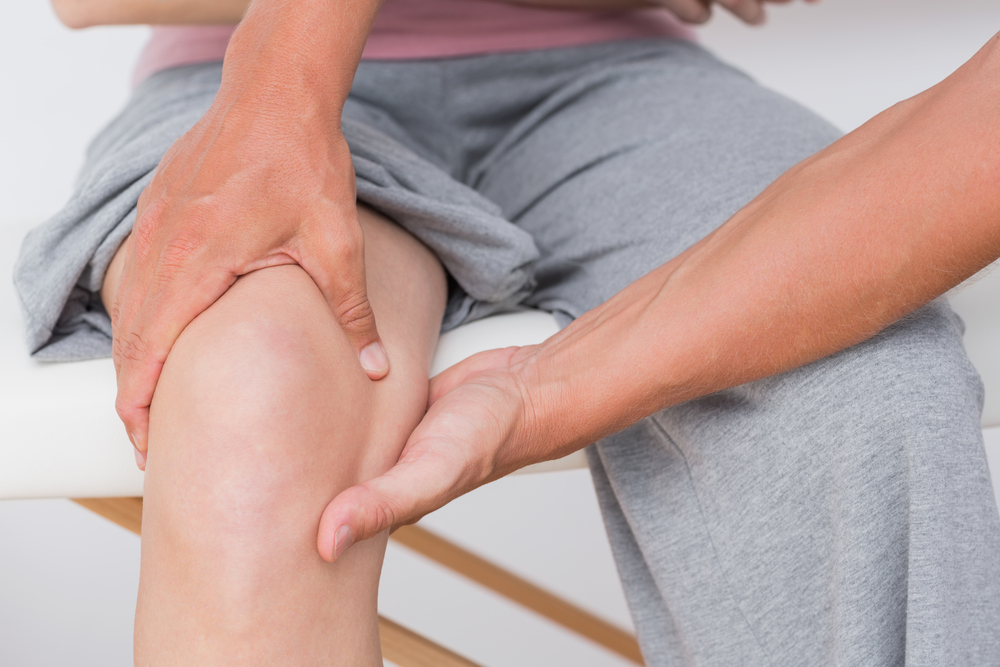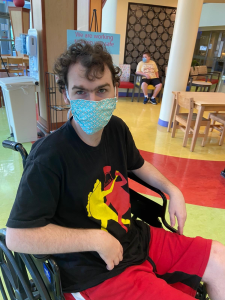Lou’s Leg Has Been Broken for Over a Year

My son Lou’s leg has been broken for 18 months. It must hurt like crazy. If I had a broken leg even for a day, I would surely be crabby, despondent, and mean. But not Lou.
Because he has Angelman syndrome, my 21-year-old son cannot speak, but he is often cheerful and interactive. In fact, because he is so agreeable, everyone assumed his bone had healed. The only clue was that he walked on the edge of his foot and leaned a little to the left.
Don’t get me wrong, Lou complains! He doesn’t speak, but he bellows, pinches, and frowns. He complains about a lack of brownies, slow rebooting of iPads, the absence of his grandmother, and a perceived shortage of sweets and pasta. He pinches whoever is handy when he is frustrated. And he uses his iPad communicator to make desperate pleas to strangers for candy and cookies. But, even with all that communicating, he didn’t complain about his leg.
The worst part is that we broke his leg on purpose. His foot was twisting as he grew, causing him to trip and fall. Once at school, he landed flat on his face, snapping off his two front teeth. Other falls broke off the replacement teeth and caused concussions, split lips, and scabbed knees and elbows. As he became a tall young adult, Lou’s falls became harder to predict. In many school activities, he had to participate from a wheelchair to prevent stitches and bruises.
We consulted many professionals, trying physical therapy, orthotics, hippotherapy, and elastic garments to address Lou’s worsening gait. Finally, we were convinced that if we didn’t operate, Lou would become wheelchair-bound. And if we did operate, he might be wheelchair-bound.
So, with trepidation, we gave the surgeon permission to saw through his femur, twist his leg outward, and insert a rod from the hipbone to the knee to point his leg forward. Lou sailed through the procedure and the worrisome post-operative period.
An X-ray indicated a normal healing process, so the doctor encouraged weight-bearing and physical therapy five days per week. Plus a dance class. The more weight-bearing, the faster the bone would heal.
About a month later at school, while shifting from his wheelchair to the lunch table, Lou fell again. Hard. He burst into one of those agonizing silent cries, with his mouth open for a long minute before the tears could even flow.
Lou’s educational assistant, Donna, who has been at his side for a decade, was shaken by Lou’s strong reaction, but encouraged by his demeanor the rest of the afternoon. At physical therapy the next day, the therapist accused me of babying Lou, convinced that his rapid mood shifts were just melodramatic.
We would ask Lou directly, “Are you in pain, yes or no? Does your leg hurt?” Most of the time, Lou would respond by pointing to a scar on his wrist, his sign for “tragedy,” but he does the same sign when we have fish instead of spaghetti for dinner.
Gradually, very gradually, Lou began to walk, and eventually we put the wheelchair in storage. But he walked on the edge of his foot, and he listed to the left. Once, at physical therapy, he tried to step over a tiny little stick. He concentrated, rocked forward and back, hesitated, and finally lifted his good foot about an inch to step over the little stick, putting all his weight on the bad leg for just a second. He burst into tears, his face contorted in pain.
So, we got another X-ray, now a full year after the operation. It showed that no healing had progressed in more than six months, and the screws had fractured, likely in the cafeteria fall. A blob of bone had grown, but the crack was still there, a situation called hypertrophic non-union. Somehow, Lou realized that walking on the edge of his foot prevented the painful twinges.
My poor, sweet boy-man, walking and dancing and therapizing without complaint. If only Angelman syndrome didn’t get in the way of proper complaining.
A CT scan last week confirmed that the crack is still there. And it must ache, or at least twinge! But somehow, Lou is walking independently again, and in the swimming pool, buoyed by the water, he hops and stands on his tiptoes!
Now what should we do? The surgeon wants to operate again and start over, because there is a small risk that the rod could snap in a fall, and maybe Lou is feeling pain. But Lou can’t tell us if his leg hurts because he has Angelman syndrome. And we can’t tell if he is in pain because he is too agreeable.
This is why we need a cure for Angelman syndrome. So Lou can become a bit disagreeable and tell us how he feels.
***
Note: Angelman Syndrome News is strictly a news and information website about the disease. It does not provide medical advice, diagnosis, or treatment. This content is not intended to be a substitute for professional medical advice, diagnosis, or treatment. Always seek the advice of your physician or other qualified health provider with any questions you may have regarding a medical condition. Never disregard professional medical advice or delay in seeking it because of something you have read on this website. The opinions expressed in this column are not those of Angelman Syndrome News, or its parent company, BioNews Services, and are intended to spark discussion about issues pertaining to Angelman syndrome.








Comments
Scott Wilcox
That article scares me, because I have no idea how much my daughter, 35, is in pain, if she hurts, or where. I don't even know if she understands the question "Do you hurt, do you have pain?". I don't know if she even knows what the words mean. The lack of ability to communicate in any meaningful manner to the world outside her poorly formed brain is the worst symptom about AS. For those people outside the AS world, it's is like having a 3 month-old child in an adult body. Forever. All we can do is guess. Trial and error.
Terry Jo Bichell
I'm also not sure if Lou can truly identify where a pain is coming from. Sometimes when I ask him to wipe his face with his napkin, he wipes the back of his head. Or if I ask him if he hurt his knee, he shows me his elbow.
Kelley Letourneau
Im so sorry he was in pain for so long. I hope he is on the mend now.
Terry Jo Bichell
I don't think it hurt all the time. I think it only hurts in certain positions, which is why he is walking on the side of his foot and leaning to one side, because that keeps it from twinging. So, I think the pain is momentary and intermittent, or at least, I hope so.
marylin Beddawi
Terry Jo:, Thank you for sharing. I am so sorry that Loui had been in so much pain and disconfort for far too long. My hart goes out to him and you guys for having to deal with so much and not knowing for sure what could be bothering him. I am glad now we know what is going on an hopefully it will be taken care for good. All my love to you guys and a big hug to Loui. xoxo, Marylin Beddawi
Terry Jo Bichell
Thanks so much, and love to you too, Marylin.
Deb Stadnyk
Hi Terry Jo
Wishing a speedy recovery for Lou! ❤️
Terry Jo Bichell
Thank you! We now have to decide if we are going to do the whole operation again, or find a novel way to try to repair the crack, or leave it the way it is (!). We tried home ultrasound treatments for 3 months, and electrode therapy for 5 months, both of which built up new bone, but did not repair the crack. I think that it is like piling up dirt on the San Andreas Fault - so that it caves in each time there is a shift, which means the only way to heal that crack is to stabilize the bone. That would mean a body cast for months, or a brand new surgery to insert a thicker rod, or maybe some really innovative engineering to put a wedge in the crack. We are working on a plan now.
Jenny Hömmen
Sascha has a broken ankle for four days before I even realised something was wrong as she walks funny anyway. We have replaced her top front teeth a few times now. If only ANGELMAN children could talk....”mum, I have a sore leg”, or “I’m feeling really unwell”. So many questions she would ask and tell me. If only....
Terry Jo Bichell
If only...
Maria Orpilla
My son broke his arm too and it took us almost a month to finally get it cast. It so hard and sad when our Angels are in pain and we just don’t know
Terry Jo Bichell
I know that they feel the pain, but they are so optimistic and sweet that they push past it when the rest of us would be crumpled up complaining.
Michael Ahern
You’re a good mom. Terry Jo!!
Terry Jo Bichell
Thank you so much, Michael.